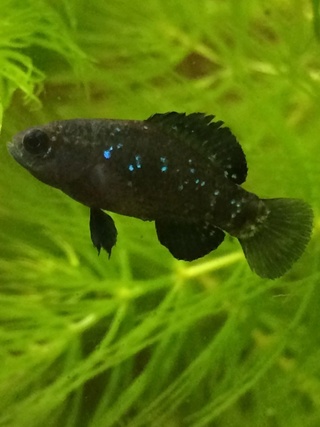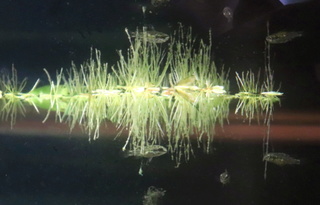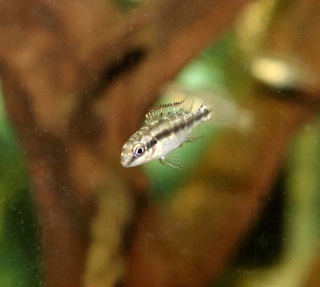General Fry care questions
3 posters
:: Freshwater :: Freshwater General
Page 1 of 1
 General Fry care questions
General Fry care questions
Hi there!
This batch of Tateurndina ocellicauda is going to be my first hatching fry ever.
I have never fed nor seen tiny fry in the past but gotten quite good at spotting newborn shrimplets.
Here are a few questions concerning fry.
1. How do you manage to spot your fry? Do you have any tricks to make them more visible?
2. How do you feed them? Let's say I plan on starting by feeding golden pearls, then newly hatched BBS?
How do I make sure everyone has enough?
What if I can't manage to see them but KNOW they have hatched (I.e: Tube now empty)
This batch of Tateurndina ocellicauda is going to be my first hatching fry ever.
I have never fed nor seen tiny fry in the past but gotten quite good at spotting newborn shrimplets.
Here are a few questions concerning fry.
1. How do you manage to spot your fry? Do you have any tricks to make them more visible?
2. How do you feed them? Let's say I plan on starting by feeding golden pearls, then newly hatched BBS?
How do I make sure everyone has enough?
What if I can't manage to see them but KNOW they have hatched (I.e: Tube now empty)
 Re: General Fry care questions
Re: General Fry care questions
I came home from work tonight and noticed stuff floating in my Endler tank. Upon closer look, it turns out to be about two dozen new fry!!! Talk about tiny, they look like pieces of lint floating in the water column. The first two batches, about eight to ten, are now large enough to readily see but the newborns are really, really difficult. There is no way to accurately count them.
I am certainly no expert, but I am feeding some Hikari daphnia alternated with Hikari Spirulina and Brine Shrimp. Both foods are dehydrated and extremely tiny. I scatter lightly on the surface, they absorb water and slowly sink, allowing the fry to eat as much as they want as it seems to slowly float down much like live insects would. Later I find the adults down cleaning the bottom. I also have some mini bloodworms and those are a hit with the bigger fry and the adults. I use those once or twice a week, being careful to not over feed those.
So far, at least, everyone seems to look and act great, and even the newborns have visible bellies after eating. I do think I lost some of the first two batches because at one time I had about a dozen, then had less a few days later but I suspect they were lunch to the adults. With this last drop, obviously MANY more than the previous ones, I suspect more will certainly survive.
The tank is planted with lots of floating plants above, a pretty empty middle and plants on the bottom. Surprisingly, the little ones seem to hang out in the clear middle area instead of hiding in the plants. Moms pretty much hang out at the top and the males stay pretty much nearer the bottom. The tank is a 20 gallon hex so there is quite a bit of water available to them all.
My original plan with my live bearers was to offer plenty of hiding places but to allow survival of the fittest and to not separate the fry from the adults. So far, Endlers are multiplying quickly, Swordtails (and the two mollies) only have about four or five survive from each drop, and the Platies usually have about two or three after the initial spawn in which eight survived. I find the older fry seem to be the biggest hazard to the newborns, especially with the Platies.
I am certainly no expert, but I am feeding some Hikari daphnia alternated with Hikari Spirulina and Brine Shrimp. Both foods are dehydrated and extremely tiny. I scatter lightly on the surface, they absorb water and slowly sink, allowing the fry to eat as much as they want as it seems to slowly float down much like live insects would. Later I find the adults down cleaning the bottom. I also have some mini bloodworms and those are a hit with the bigger fry and the adults. I use those once or twice a week, being careful to not over feed those.
So far, at least, everyone seems to look and act great, and even the newborns have visible bellies after eating. I do think I lost some of the first two batches because at one time I had about a dozen, then had less a few days later but I suspect they were lunch to the adults. With this last drop, obviously MANY more than the previous ones, I suspect more will certainly survive.
The tank is planted with lots of floating plants above, a pretty empty middle and plants on the bottom. Surprisingly, the little ones seem to hang out in the clear middle area instead of hiding in the plants. Moms pretty much hang out at the top and the males stay pretty much nearer the bottom. The tank is a 20 gallon hex so there is quite a bit of water available to them all.
My original plan with my live bearers was to offer plenty of hiding places but to allow survival of the fittest and to not separate the fry from the adults. So far, Endlers are multiplying quickly, Swordtails (and the two mollies) only have about four or five survive from each drop, and the Platies usually have about two or three after the initial spawn in which eight survived. I find the older fry seem to be the biggest hazard to the newborns, especially with the Platies.

nyleveiam- Veteran Member

- Posts : 1383
Join date : 2014-02-05
Location : New Hampshire, USA
 Re: General Fry care questions
Re: General Fry care questions
l_l_l wrote:
1. How do you manage to spot your fry? Do you have any tricks to make them more visible?
2. How do you feed them? Let's say I plan on starting by feeding golden pearls, then newly hatched BBS?
How do I make sure everyone has enough?
Good questions. With my livebearers I keep a lot of java moss so that there is refuge. In your case, perhaps there are plant hiding spots available to them. Fry have a natural instinct to avoid larger fish so they will gravitate towards vegetation. If they are surface oriented, you may want to have frogbit or salvinia. These plants will not only provide them cover but also small food. I keep a lot of detritus in the bottom (though many will prefer not to do this) as a source for food. Having plants will allow you to see them against the green backdrop. If they are attached you may want to use a flashlight to illuminate their outline.
Golden pearls are an excellent first food, though I have not used them recently as I go straight to BBS. You can see that the fry are eating since they have orange bellies when they have fed. You will also see them "peck" at the BBS as they are eating each one. As BBS will be able to live as long as a day in freshwater, you will have a good supply for them to eat. I usually turn off the filtration to omit current and avoid the filter from sucking up the BBS before the fry can get to them.
In my case, I colony breed my livebearers since the fry are large enough to survive on their own. As to which livebearer you can do this with, that is species dependent. In general, all fish will eat little fish so always provide some refuge for the babies to go to in a tank. In some cases the juveniles are worse than the adults for eating fry.
I have recently been using birthing boxes for gravid females with two species in order to increase the fry output. In the regular tanks there still are fry which are left with the adults, so colony breeding still occurs and young grow up in the same tank. As a rule if there are little fry in the tank, the adults are conditioned to having fry around so they tend not to chase them. If there have not been fry, then you will need to introduce some dither fish.
I am currently raising some small fry from the Poecilia caucana and Phallichthys quadripunctatus in the birthing container. I feed them BBS twice a day. The birthing container has a lot of java moss as well as snail. Snail poop is an excellent starter for infusoria. Hope this helps.

alexmtl- Veteran Member

- Posts : 3274
Join date : 2013-09-07
Location : Montreal Quebec
 Re: General Fry care questions
Re: General Fry care questions
nyleveiam wrote:
The tank is planted with lots of floating plants above, a pretty empty middle and plants on the bottom. Surprisingly, the little ones seem to hang out in the clear middle area instead of hiding in the plants.
My original plan with my live bearers was to offer plenty of hiding places but to allow survival of the fittest and to not separate the fry from the adults. So far, Endlers are multiplying quickly, Swordtails (and the two mollies) only have about four or five survive from each drop, and the Platies usually have about two or three after the initial spawn in which eight survived. I find the older fry seem to be the biggest hazard to the newborns, especially with the Platies.
This is a good way to raise the colonies. Yes you will lose some fry but these fish are so prolific that you will have more than enough to grow to adults. It is always good to see a mixed population in a tank. Great job !

alexmtl- Veteran Member

- Posts : 3274
Join date : 2013-09-07
Location : Montreal Quebec
 Similar topics
Similar topics» Back from vacation - fish care with no fishkeeper?
» 2 questions
» Bacteria Questions
» Feeding questions
» Filtration questions
» 2 questions
» Bacteria Questions
» Feeding questions
» Filtration questions
:: Freshwater :: Freshwater General
Page 1 of 1
Permissions in this forum:
You cannot reply to topics in this forum
 Alexmtl
Alexmtl


» Anyone still around? Need help transporting fish
» Stocking suggestions
» New Tank Purchase
» 3 Gallon Tetra half moon tank
» White floaty stuff in gold fish tank
» Ammonia in tap water
» Need advice for beginner with fresh water tank
» Fluval FX5 hose size?
» smart fish, dumb fish, pink fish...um, what rhymes with dumb?
» Is K&E sandblasting sand same as Black diamond?
» What the...is that a leak? NOOOOOOOOOOO!!!!! (a comedy of horrors...)
» Air stones and the noise they make
» aquatic medications
» film like stuff on the water surface of shark tank
» Articles on swordtail behaviour and fathead minnows
» Lets see your predators!
» Humane way to PTS a shark
» My tanks (Introducing myself)
» Build your own aquarium